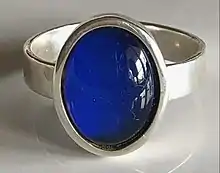
A mood ring is a finger ring that contains a thermochromic element, or "mood stone", that changes colors based on the temperature of the finger of the wearer. Finger temperature, as long as the ambient temperature is relatively constant, is significantly determined by peripheral blood flow, which is modulated by the autonomic nervous system. A mood ring contains liquid crystals that change color depending on the temperature.[1]
History
The idea to use thermosensitive elements in jewelry first arose from the American jeweler Marvin Wernick in 1974 after reading a magazine article about the use of liquid crystal elements in medical thermometers.[2] He found a compound that changed color from black to green, blue and deep blue in the range of 32–38 °C and in January 1975 developed a technique for using it in pendants and rings.[2] Sales began in February. Wernick called the jewelry "magical", and his promotional materials claimed that the color of the pendant or ring is an indicator of the warmth of the wearer's character.[3] Since Wernick did not patent the invention, other jewelers adopted the idea and began to produce their thermosensitive jewelry. Soon someone came up with a successful term "mood ring", which was quickly adopted by all manufacturers, including Wernick.[4]
An important producer of "mood rings" was Joshua Reynolds; some sources call him their inventor.[5] Reynolds called the rings "a real biofeedback tool" that allows a person to get additional information about their body.[5] In December 1975 the total value of the rings sold reached $15 million.[6] However, in mid-December, the demand for rings suddenly fell as the market was oversaturated, and companies that did not have time to sell rings suffered losses.[7] After a couple of years, "mood rings" went out of fashion.[6]
See also
References
- ↑ Marechal, Catherine; et al. (2019). "Survey on AI-Based Multimodal Methods for Emotion Detection". In Kołodziej, Joanna; González-Vélez, Horacio (eds.). High-Performance Modelling and Simulation for Big Data Applications. Springer. p. 308. ISBN 978-3-030-16272-6.
- 1 2 Shook 1982, pp. 423.
- ↑ Shook 1982, p. 44.
- ↑ Shook 1982, p. 45.
- 1 2 Sagert 2007, p. 126.
- 1 2 Sagert 2007, p. 127.
- ↑ Shook 1982, pp. 47–48.
Sources
- Sagert, K. B. (2007). "Fads: Mood Rings". The 1970s. Greenwood Press. p. 126—127. ISBN 978-0313339196.
- Shook, R. L. (1982). "Why didn't I think of that!". The Mood Ring. New American Library. p. 38—49. ISBN 0453004199.